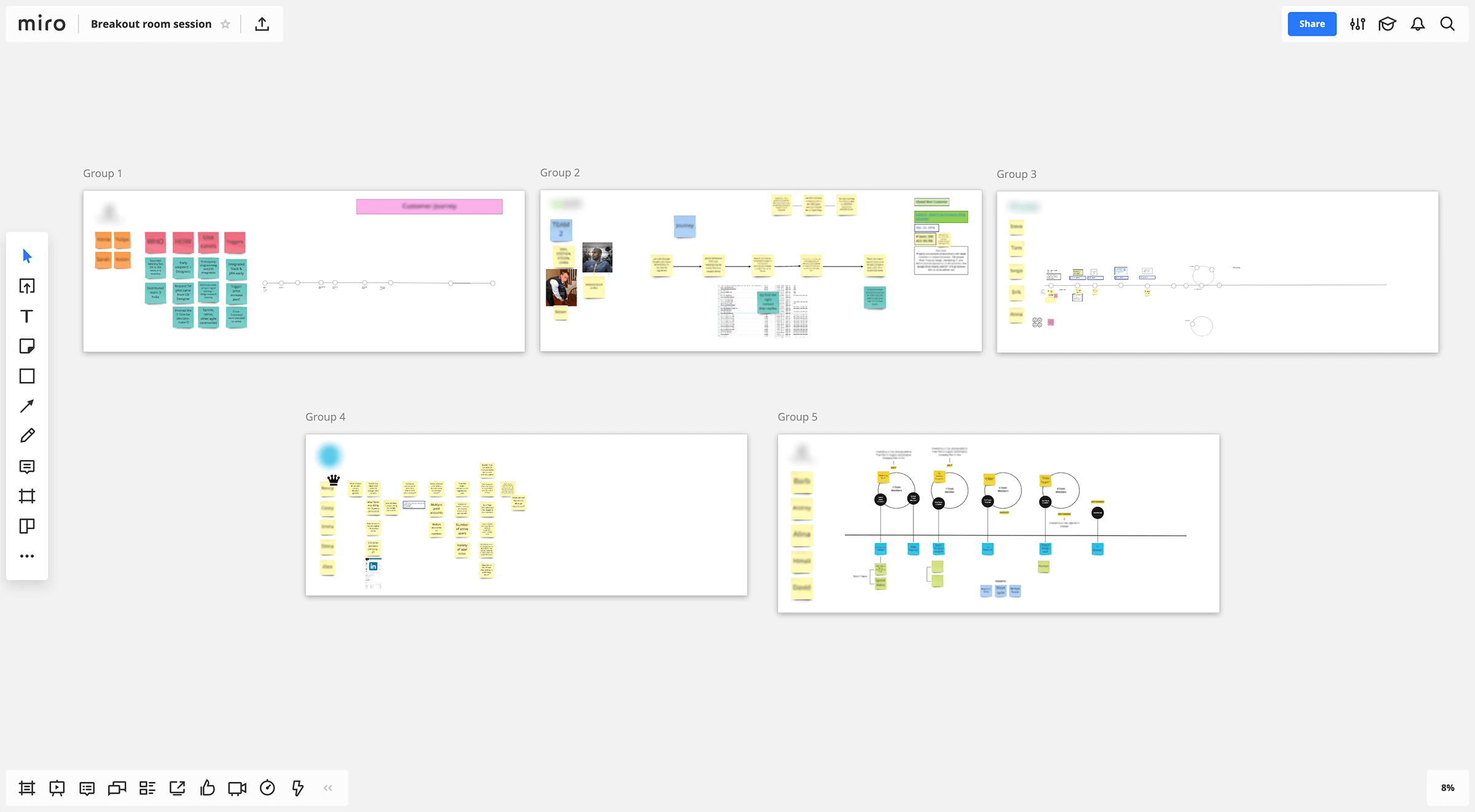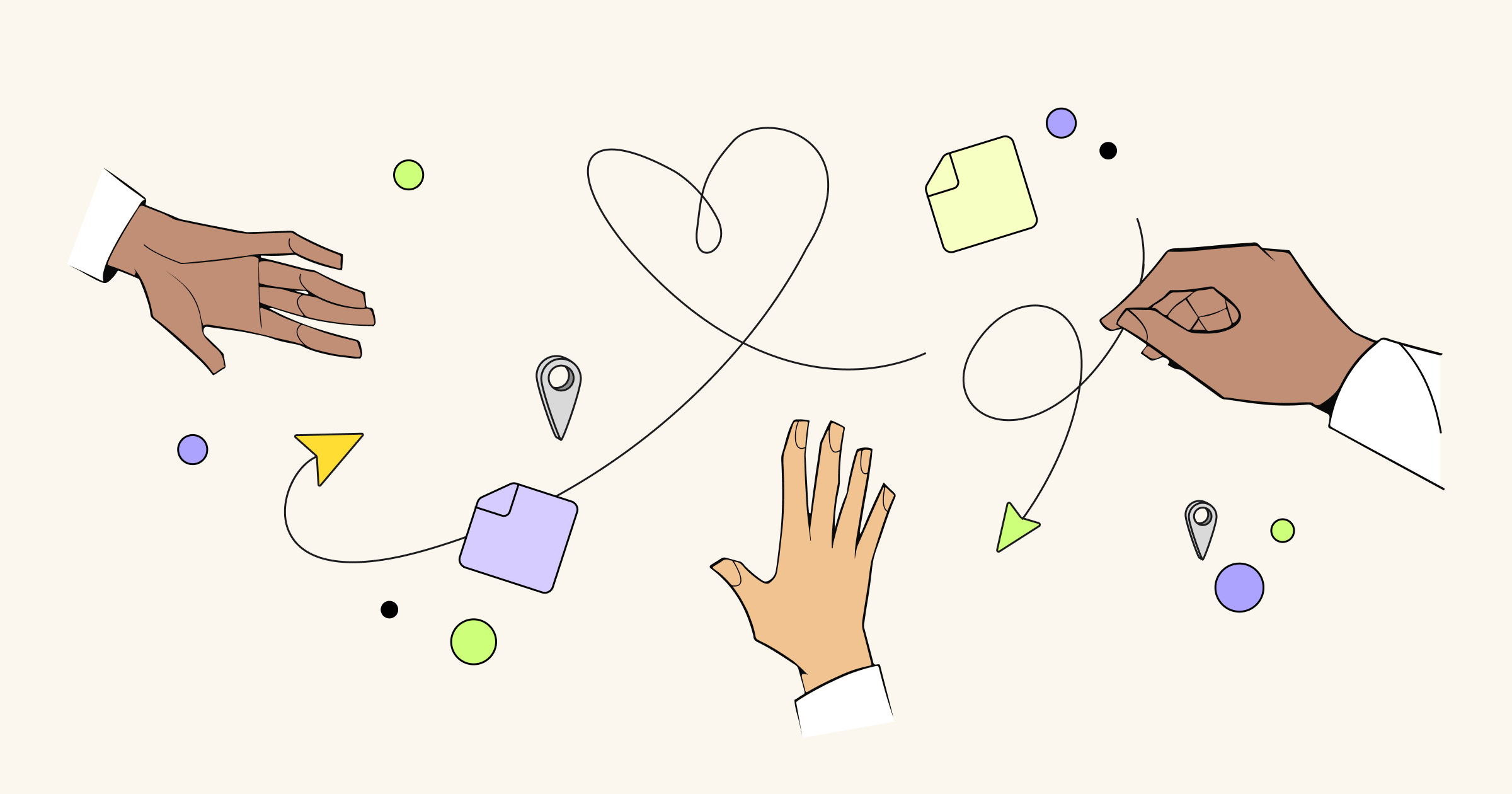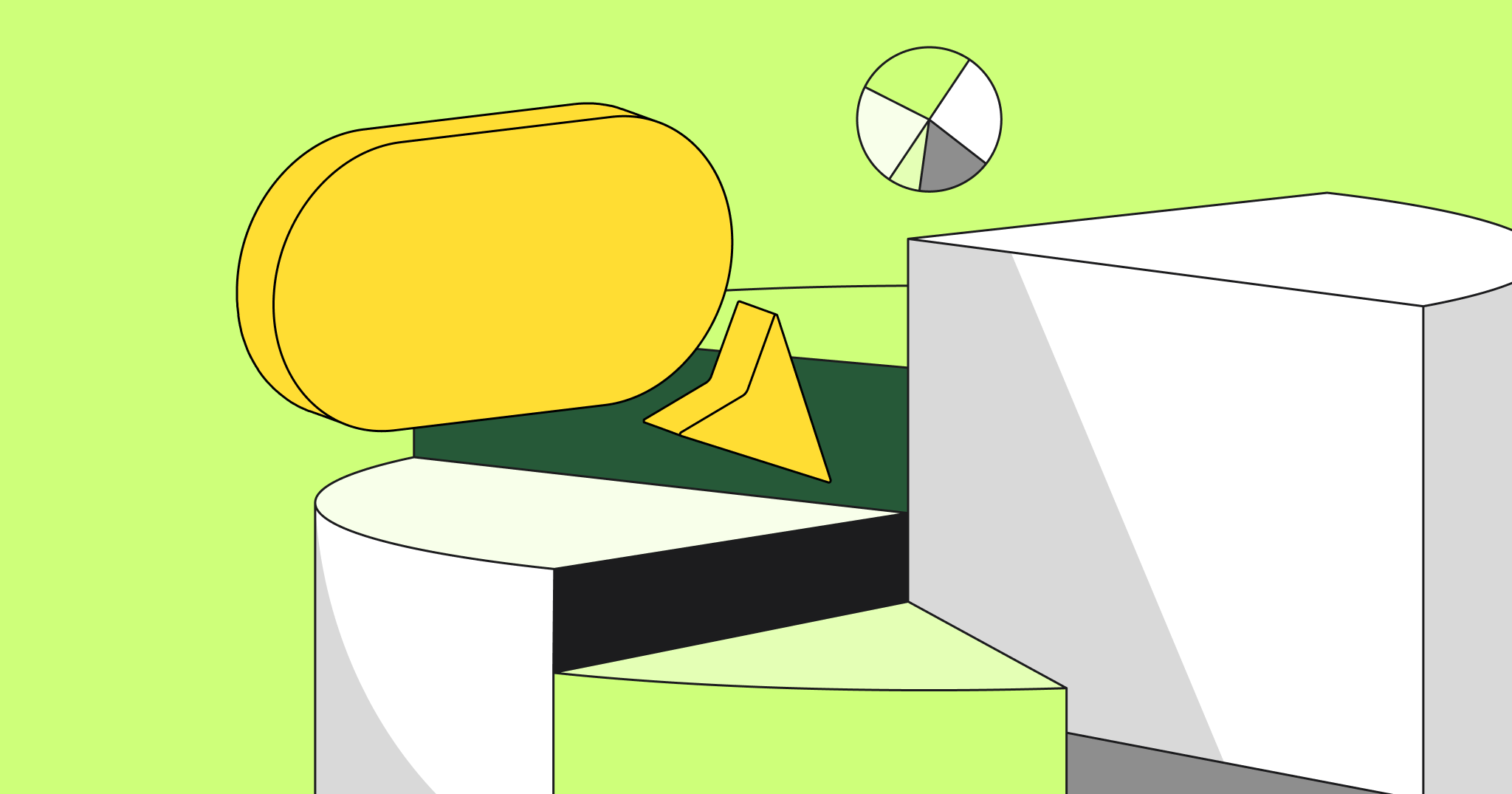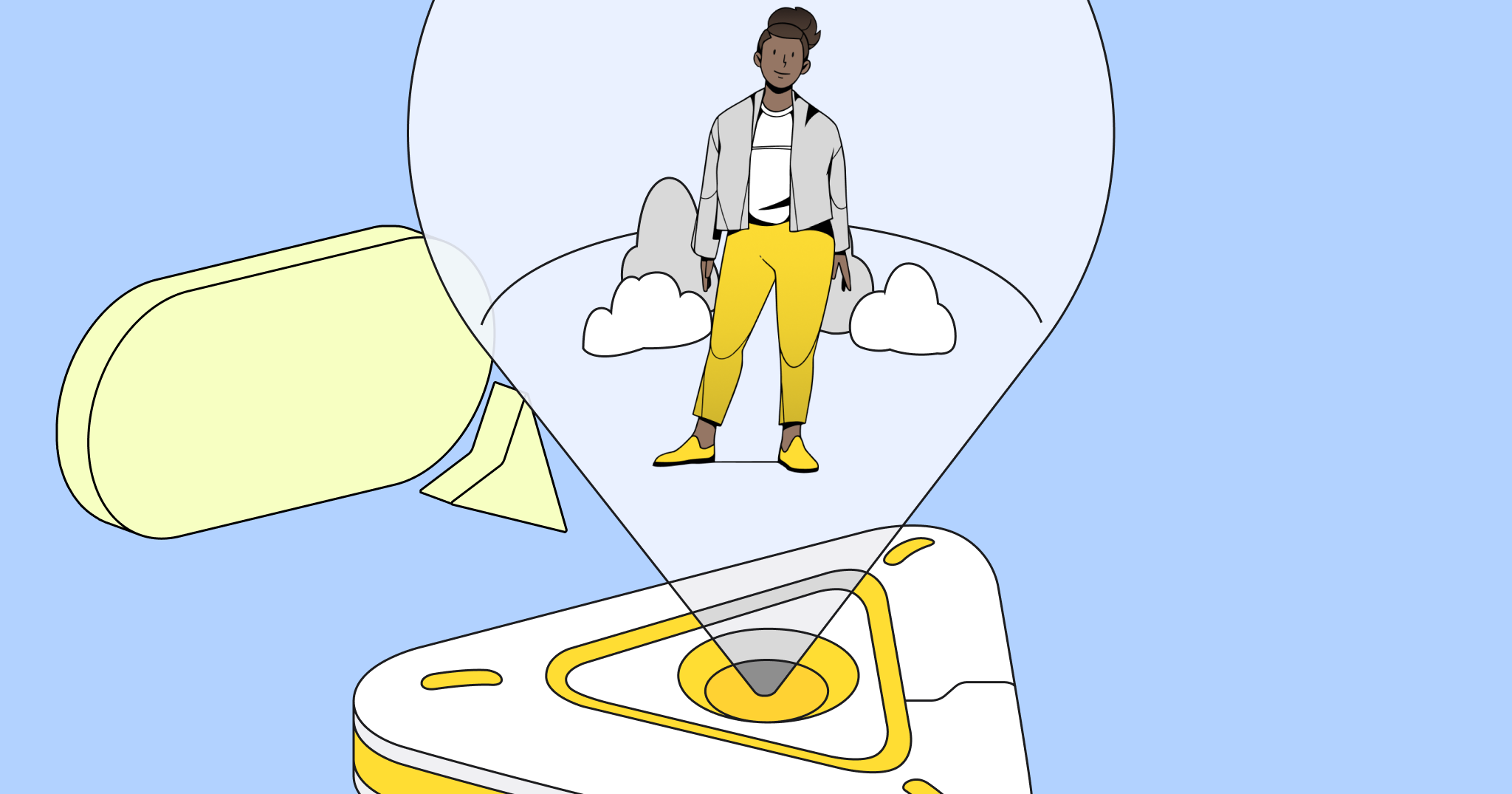How do you decide how to collaborate for a specific project? Here at Miro, we’re a globally distributed company tackling cross-functional challenges; We need to align on the best, most agile way to solve them together.
While a colocated team may just jump into a room for a spontaneous brainstorm, we need to be more thoughtful and deliberate. We carefully consider: Who should be involved in this meeting? How do we best present this information? What tools should we use to work together?
As the VP of Operations, I look to measure and validate the ways we solve problems so collaboration happens efficiently, produces high quality outcomes, and maximizes the value from the resources used.
In this article, I am going to walk you through how we got the most out of an hour and a half collaboration between 30 people from 6 different teams across 5 time zones — some colocated in the same office, others remote — to reverse engineer the customer journey. By walking through our process, I hope this enables you and your teams to be more strategic and adaptive in solving your own big, sticky, cross-functional challenges.
How do you measure effective collaboration?
Collaboration can take a multitude of forms: presentations, meetings, sticky-note brainstorms, sending prototypes to another team and receiving feedback. What I care about with collaboration in any form is the quality and outcome of the exchange so projects are moving forward in the smartest, most generative ways possible.
Here are the four criteria by which I measure a successful outcome of a collaboration:
Quality of collaboration
The in-the-moment experience and environment is crucial to empower participants to engage and act. Focus on how people are interacting, communicating, and creating together.
Quality of outcome
This measure focuses on optimizing the quality of ideas and outputs for fast decision cycles. Collaboration is only effective if there’s something to take away from it. Effective collaboration makes execution easy.
Financial cost of collaboration
If you are collaborating with a distributed team, is your meeting remote or will you fly people out to the same place? I consider the financial burden of a collaboration in terms of cost of travel and cost of person-hours dedicated to the project and collaboration.
Time efficiency of collaboration
Hand-in-hand with cost, the amount of time in person-hours (time spent on the collaboration multiplied by the number of collaborators) is an important factor to consider to remain agile. The goal here is to increase the ratio between the outcome of the collaboration and the time it took to do it.
[rtb_inline_subscription id=”1″ size=”small” header=”Subscribe to learn more about managing remote teams!” button=”black”]
How to enable effective collaboration
Here are the conditions I’ve identified to optimize for each of the measures of effective collaboration above.
Structure: goal-oriented
For collaboration to be successful, it must be structured around an end goal. At the outset, it’s crucial to define what success looks like during and after. This is a useful way for all stakeholders to frame their efforts around the goals and expectations of the collaboration to maintain momentum and focus toward the outcome.
It’s also important to find the sweet spot between being too open and too closed. Try and design a collaboration with opportunities for expansive, bottom-up thinking with a structure that focuses the conversations, insights, and data.
Tools: flexible and accommodating
Choosing the adequate tools for people to learn, interact and engage with each other in person or remote is key to the effectiveness of collaboration. You should consider tools that accommodate a range of learning and collaboration styles, tools that organizes brainstorms and discussions, and tools that bring distributed teams together.
Participants: diverse and relevant
Research shows that the more diverse a group is in job role, function or seniority, the better the collaborative atmosphere, the more creative the ideas. A diverse collaborative environment with the relevant stakeholders (no matter how many) to the project helps reduce group-think, and leads to more innovative and creative ideas with different modes of operating and thinking in the room.
Environment: open and inspiring
For meetings to be conducive to participation, engagement and comfort to generate ideas and work together, the environment should be one that is open and trusting. Collaboration should minimize groupthink, cut across hierarchical relationships, and facilitate sharing.
Case Study
To demonstrate how are learning to optimize for successful cross-functional collaboration, let’s take a look at a recent workshop we did. Our Director of Demand Gen & Growth Marketing, Suzanne Holloway, wanted to create a collaborative strategy session with cross-functional teams across Sales, Marketing, Growth, and Product – including team members separated by a 12-hour time difference. The goal was for each group to deep dive into certain customer cases to gain a better understanding of the customer journey.
At the outset, there were multiple potential approaches we could have taken to tackle this project, which we’ve outlined and compared below.
For this exercise, Suzanne initially considered doing a presentation and group brainstorm to six key stakeholders. But, she also wanted to maximize input from team members on the ground collecting and analysing customer data, while not expending resources to fly global teams to one location. To execute on this, she included 30 stakeholders, trying a variation of Option 3, described below, using a new confluence of tools to execute it: Zoom breakout rooms and Miro boards with the customer journey mapping templates.
Online presentation and discussion with a small group of six key stakeholders from different teams.
In-person presentation, with physical breakout room sessions with 30 stakeholders (both team leads and specialists).
Online presentation and breakout room session with 30 stakeholders (team leads and specialists), video-ing in from distributed locations.
Time efficiency
6 collaborators during 1.5-hour session = 9 person-hours
30 collaborators, 1.5 hr collaboration, additional time for travel to the collaboration (4 hours/person) = 165 person-hours (~3 weeks of work).
30 collaborators for 1.5 hr collaboration = 45 person-hours
Cost efficiency
100% Remote: $0 spent on travel
Flights and housing for one night: $500 per person= $15,000
100% Remote: $0 spent on travel
Pros
Only the necessary decision-makers are in the room, saves overall person-hours dedicated to a single project, simplicity of format, intimate discussion.
Face-to-face collaboration, efficient, clear, trusting, human, energetic and fun.
A lot of voices in one room, diverse type of collaboration with large and small groups, larger variety and creativity of ideas born out of small cross-functional collaboration, fun and new format.
Cons
Group-think, fewer diversity of ideas, those on the ground working with the data don’t have a voice, brainstorm fatigue.
Resources to fly a team out, wasted time in travel.
Engagement might lack in the final share-out as remote engagement can wane.
How did we execute this approach to optimize effectiveness? Here are my observations of the experience:
Structure
Benefits: This exercise was framed around formulating a well-defined customer journey. The three-part format of the collaborative session — a presentation to a small-group brainstorm then a group discussion — contributed to the end goal by giving enough background and organization for people to easily participate, while still maintaining opportunities for creative brainstorming.
Considerations: This multi-part session requires pre-work to set up the background information and templates to help scaffold the brainstorm. Additionally, each breakout group collected and presented their information differently. As a consequence, it took time after the collaboration to compare and synthesize all of the data.
Tools
Since we chose to conduct this remotely, we needed a way to talk and work together in a live, visual format. To do this, we decided to use a shared Miro board for all breakout groups to collect and organize their data and ideas; it accommodated those that think visually, those that had data and photo assets, and those that took notes.
Benefits: The customer journey map template that everyone organized their ideas around helped provide a basic architecture for organizing group brainstorms, while being unstructured enough for there to be a variety of approaches in thinking about the customer journey. The Zoom breakout room also allowed for us to get more detail and quality of information by combining large and small group discussions.
Considerations: Be ready to capture and synthesize the variety of ideas and insights from five different teams with five different ways of visualizing their thinking.

Participants
Expanding the group from six to 30 people across five time zones made this project a logistics and planning feat. While including this number of stakeholders is quite the time and resource investment, we thought it was worthwhile for this particular project.
Benefits: With this number of stakeholders came a diversity of perspectives: The random mix of seniority and job roles meant each person was bringing something new to the table. It also created renewed buy-in for individuals to contribute their daily work to a company-wide project.
Considerations: I advise that you carefully examine the value that an interactive collaboration with a lot of stakeholders will bring to your project. Especially with 30 stakeholders involved, it is a lot of company time and resources to invest in a single project.
Looking for a tool to manage your remote product team?
Try Miro free
Environment
Benefits: The mix of formats from presentation, to small group brainstorms to large group discussion kept things lively and engaging. It was time efficient for that reason as it kept moving the group forward toward the next goal. Breakout rooms were made sharing less intimidating because of the small group format.
Considerations: While there are significant cost-saving benefits to remote, video-based work, you need to be purposeful about continuing group engagement at the end of the session when teams are sharing out their results. Video communication is a medium where collaborators can become lazy participants and listeners.
What is a breakout room?
Conceptually, a breakout room is a separate space in which a large group splits up into smaller groups to collaborate. In a Zoom conference call, you can choose to randomly break the team out into rooms, or you can pre-set the small groups. You then time-box the breakout session, so that individuals break out for a set period of time, then rejoin the main call when the breakout session is complete. Here’s what ours looked like:
- First 30 minutes: A project lead presents to group for 30 minutes with background information, goals and frameworks of the working session on a conference call.
- Middle 30 minutes: Move into random Zoom breakout rooms with open brainstorming, documented on Miro. The project lead has the freedom to pop into any breakout room to help moderate and steer conversations toward the end goal.
- Last 30 minutes: Come back together and share each breakout group’s insights, 5 minutes each, consolidating ideas into a single visual format. For us, this collaboration and presentation happened on a Miro board.]
Things to consider
We are excited about this particular experiment with Zoom breakout rooms with Miro as one method of soliciting ideas, insights, and brainstorms in a mixed format of collaboration. That said, this is only one potential format that fairly successfully meets the effective collaboration criteria.
As you tackle your own cross-functional projects, I recommend you design your collaborative process with these questions in mind: to whom is this relevant? To whom will this collaboration bring value? In what format is this information best conveyed? And, most importantly, how will I measure success from this time collaborating together?






